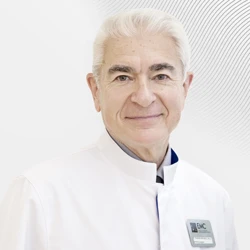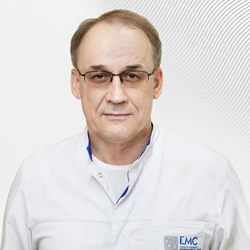Urologist
The gallbladder is a pear—shaped organ that is located on the lower surface of the liver in the upper right quadrant of the abdomen. Bile accumulates in the gallbladder cavity, which is released into the duodenum after eating and participates in the breakdown of fats. In some cases, with impaired gallbladder function, bile outflow from the gallbladder, metabolic disorders, and also with genetically determined factors, dense deposits form in the organ— stones. The method of treatment of formed stones is only surgical, and it is necessary to remove the gallbladder.
Cholecystectomy is one of the most common operations in the world.
When do I need surgery?
Cholecystectomy is most often performed for gallstones and gallbladder polyps.
-
In cholelithiasis, surgery is performed in the presence of symptoms or complications— acute cholecystitis, stone migration into the common bile duct (choledocholithiasis) and subsequent cholangitis, pancreatitis, etc. Asymptomatic cholelithiasis is not an indication for surgery, butAn individual approach is needed. If the patient has stones in the gallbladder, a consultation with a surgeon is recommended to select treatment methods. Surgical treatment is more often recommended in the presence of small stones in the gallbladder (up to 5 mm), as small stones are more dangerous than large ones.
-
In case of gallbladder polyps, surgery is recommended if the polyp size is 10 mm, multiple polyps or objective signs of their growth and an increase in the number detected during the observation process.
Types and features of gallbladder removal operations
In the EMC clinic, cholecystectomy is performed using one of the following methods.
Laparoscopic
Organ removal is performed through 3-4 small "punctures" of the anterior abdominal wall.
Advantages for the patient:
-
Scars from surgery 1-2 centimeters long;
-
Faster wound healing;
-
Less postoperative pain;
-
Shorter hospital stay;
-
Reduction of blood loss and frequency of blood transfusions;
-
Minimal risk of infection.
This is the most frequent and optimal option for performing surgery today. The EMC clinic employs expert surgeons, which allows you to safely and quickly solve the problem even in complicated cases of gallstone disease.
Robotic
Robot-assisted gallbladder removal, performed by an expert robotic surgeon.
The instruments are inserted into the patient's abdominal cavity through small openings. The surgeon is located behind the control console and works with the robot's instruments using sensors controlled by the fingers. The system transforms the surgeon's motor skills into very precise robot movements. Manipulations are performed in real time: the robot does not perform any independent actions, but is an extension of the surgeon's hand. Thanks to modern visualization, even the smallest details and nerve connections are visible on a three-dimensional image. The operating area is transformed into a high-resolution 3D image with magnification up to 10 times.
The technique allows even very complex operations to be performed with guaranteed control and high precision, the robot compensates for involuntary movements, which reduces tissue injury.
Traditional or open
The operation is performed through a large incision (from the sternum to the navel or parallel and below the right costal arch). It gives the surgeon more opportunities for complex variants of the course of the disease (complicated acute cholecystitis, including peritonitis, intervention on the bile ducts, etc.).
It is more often performed in emergency situations, when the laparoscopic version of the operation does not allow to cope with the problem. In recent years, these are isolated operations in the practice of the EMC clinic.
How to prepare for gallbladder removal surgery (cholecystectomy)?
A detailed preparation plan for cholecystectomy is determined by the surgeon during the initial consultation.
Before surgery, an examination is performed to identify the presence of changes that potentially increase the risk of surgery and correct them.
Most often, the examination plan looks like this:
-
preoperative examination, including the delivery of necessary blood tests,
-
performing MRI cholangiography, ECG,
-
radiography or CT scan of the lungs,
-
consultation with a therapist, anesthesiologist, and, if necessary, related specialists.
On the day of the operation itself, we recommend that you refrain from eating (a light dinner the day before), as well as water (at least 6 hours before the operation).
If the patient is constantly taking medications (for cardiac arrhythmias, hypertension, diabetes, etc.)— taking medications must be coordinated with consulting specialists at the stage of preoperative examination.
You will also need antiembolic (compression) stockings, which will be provided at the hospital.
If there is a hairline, it is necessary to remove the hair from the abdomen, it is better to do this at the clinic immediately before the operation, the medical staff of the clinic will help with the preparation.
What should I take with me to the hospital?
With laparoscopic and robotic cholecystectomy, hospital stays rarely take more than two days, so the number of items may be minimal.
A list of necessary items will be provided by surgical assistants who will accompany the entire process of examination, hospitalization, and discharge from the hospital.
How is the hospitalization and the perioperative period?
The entire stage of pre-hospital examination, hospitalization, hospital stay, discharge is monitored and accompanied by surgical assistants, which allows you to comfortably walk this path.
The patient arrives at the EMC clinic 2.5-3 hours before the planned operation. The patient is examined by a general practitioner in the emergency department, and then by a surgeon and an anesthesiologist, who can once again be asked all questions about the upcoming operation.
After the conversation, you will need to read and sign an informed consent for surgery and anesthesia (consent can be signed when planning the operation at the preparation stage).
After the preparation (shaving, showering, putting on compression stockings, injecting a sedative into a vein as prescribed by an anesthesiologist), the nurses take the patient to the operating room at the appointed time, where the surgeon performs the planned operation under anesthesia.
After the operation, the patient is transported to the wake-up ward under the supervision of an anesthesiologist. After 1.5-2 hours, with a smooth flow and awakening, the patient is transported to the hospital ward, where early rehabilitation, activation, and anesthesia will be performed under the strict guidance of the attending physician and the supervising therapist.
Rehabilitation after surgery
The concept of rapid rehabilitation (ERAS -Enhanced Recovery After Surgery), adopted in our clinic, makes it possible to minimize the duration of hospitalization and in most cases does not exceed 1-2 days.
At home, we recommend continuing to take painkillers: they are usually required for several more days, then the pain practically does not bother — patients' well-being improves every day.
Daily dressings are needed, which can be done independently: after a shower, you need to remove the bandage, treat the wounds with antiseptic (betadine, chlorhexidine) and seal with new bandages. Bandages are used within 5-7 days after surgery. Everything necessary for bandages is provided to the patient on the day of discharge, along with recommendations for implementation.
It is necessary to limit physical activity and weight lifting to no more than 5 kg per month until the scars heal.
The diet after surgery and all recommendations are given by the operating surgeon or his assistant, including those prescribed in the discharge epicrisis, which can be provided in any form convenient for the patient— on paper, by e-mail or in the messenger.
Don't let the disease deprive you of a fulfilling life. Without treatment, gallstone disease carries the risk of serious complications. The operation will help you quickly return to your favorite activities.
If your condition worsens or you have any questions, please call/write +7-495-933-66-55.
EMC Clinic specialists' support is available around the clock:
-
call to the call center (+74959336655)
-
WhatsApp chat with call center staff (+74959336653)
-
chat in your Personal account of the EMC
-
corporate email of surgical assistants (asap@emcmos.ru )- available from 08:00 to 20:00 daily
Frequently asked questions
How long does the operation to remove gallstones from the gallbladder take?
Depending on the complexity, the operation takes 30-120 minutes.
What kind of anesthesia is used to remove gallstones?
Removal of the gallbladder is performed only under general anesthesia. Intubation (endotracheal) anesthesia is usually used, which is combined with artificial ventilation for the best control of the patient's condition.
Is it possible to do without surgery for gallstones?
It all depends on the size and quantity of the stones, as well as the dynamics of their increase in size and quantity. The decision about the operation is made by the doctor on the basis of regular monitoring and monitoring of the patient's health status.
What size of gallstones is dangerous?
Risks exist with stones of any size. Small stones (up to 5 mm) can migrate from the gallbladder into the duct and clog it, causing mechanical jaundice (choledocholithiasis). A stone measuring 5-20mm can block the neck of the gallbladder, provoking acute obstructive calculous cholecystitis. Large stones provoke the formation of pressure sores and thinning of the gallbladder wall, which over time can lead to its rupture.
Is it possible to remove gallstones from the gallbladder without removing the gallbladder?
Most often, patients with gallstone disease are offered surgery to remove the gallbladder — this method is considered the safest and most effective.
What can not be done with stones in the gallbladder?
To prevent exacerbations of chronic cholecystitis, it is necessary to follow a diet and avoid foods that increase the mechanical, chemical and thermal effects on the digestive tract. It is recommended to avoid foods that make digestion difficult (fatty meats, smoked meats, lard), spicy and sour sauces and seasonings (mustard, pepper, marinades, vinegar), foods that provoke gas formation (legumes, rye bread), pastries, confectionery, alcohol.
Why the EMC
The first and only clinic in Russia, created in the image of the world's leading clinics
EMC is a multidisciplinary center offering patients a high level of medical services and a personalized approach
Worldwide recognition and awards
 Learn more
Learn more
Worldwide recognition and awards
 Certificates and licenses
Certificates and licenses
Make an appointment for a consultation
Specify your contacts and we will contact you to clarify the details
Reviews
and new products of the EMC



.webp)
.webp)



